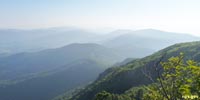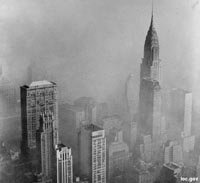8.7: Dust, Aerosols, and Cloud Condensation Nuclei (CCNs)
- Page ID
- 10268
Dust, Aerosols, and Cloud Condensation Nuclei (CCNs)
Cloud condensation nuclei (also known as cloud seeds) are small particles typically 0.2 µm, or 1/100th the size of a cloud droplet on which water vapor condenses. CCNs are aerosols, an aerosol is a colloidal suspension of microscopic particles dispersed in air or gas. The aerosols can be a combination of solid particles and liquid compounds (liquid water or organic residues).
Examples of CCNs include:
- dust particles (clays) - most are from wind storms in desert regions (see NASA video with Figure 8.16)
- soot from fires
- volcanic ash
- salts from sea spray
- sulfate compounds released by phytoplankton in the oceans
- pollen and organic aerosol compounds released by land plants (Figure 8.17)
- pollution (smog) (Figure 8.18).
CCNS are abundant in the air. The adhesion properties of water, allows water droplets (or ice) to form and grow on CCNs, until gravity is strong enough for droplets to fall as rain or snow. However, too many CCNs in the air can prevent water droplets or ice crystals from growing large enough to fall as precipitation (rain or snow), contributing to often thick haze or smog).
 |
 |
 |
| Figure 8.16. Dust from desert regions is a major source of CCNs. See Atmospheric aerosol/dust video (NASA) Globe version (NASA) | Figure 8.17. Natural CCN aerosols released by plants produce the haze of the Smoky Mountains region of the Appalachian Mountains. | Figure 8.18. Smog in NYC in the 1970s. Air pollution from human activity is an increasing source of CCNs in the atmosphere. Smoke from manufacturing, vehicles (particularly diesel-burning trucks), coal-burning power plants, and construction dust are significant sources. Efforts to regulate CCNs have helped reduce smog in the US, but what about China? |
NASA Atmospheric Aerosols on a globe (YouTube animation)


